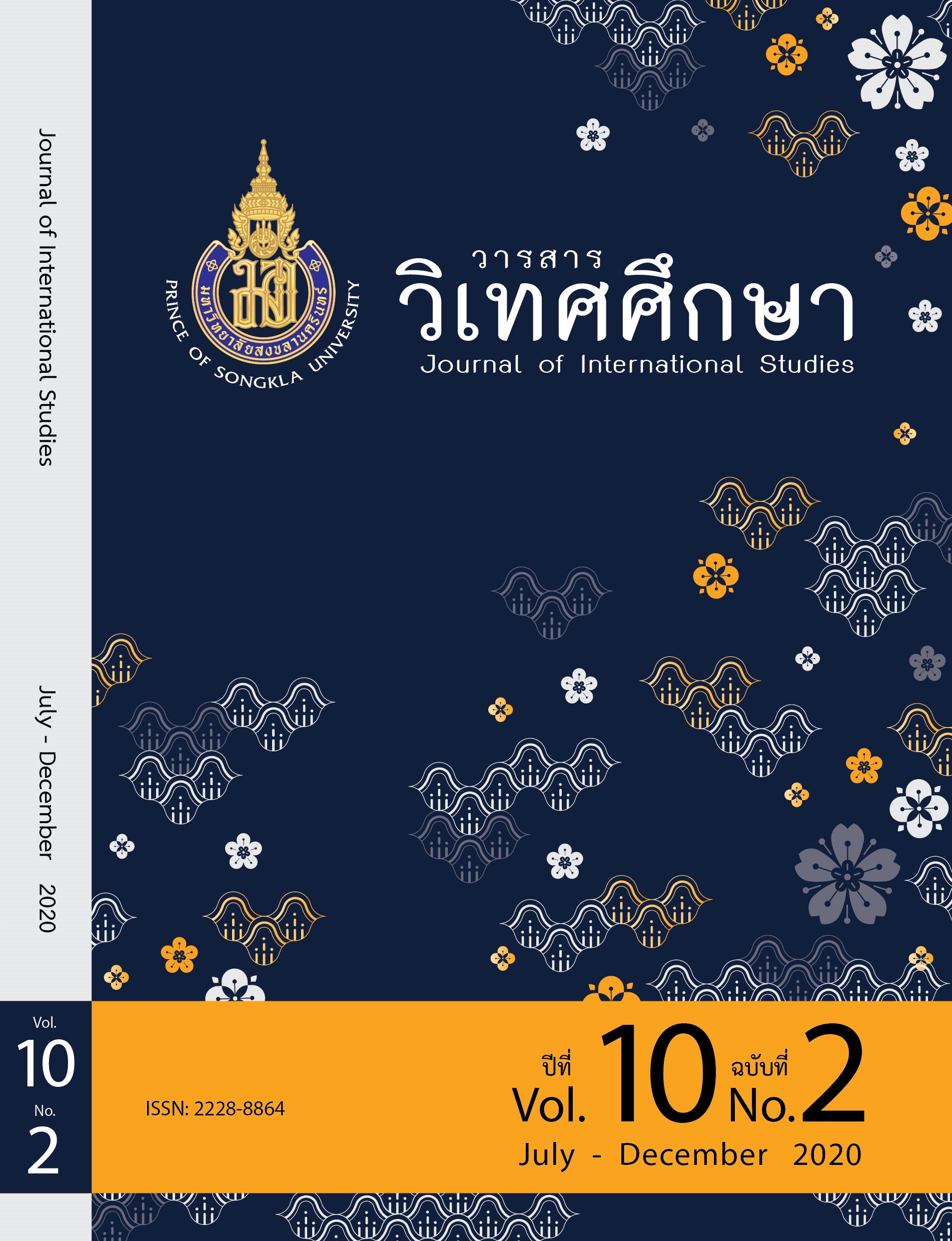Use of Marketing Content for Marketing Communication of the International Orchestras
Main Article Content
Abstract
The objectives of this research were to study the techniques and feedback of using social media that the world-class orchestras and the Asian region orchestras use for marketing communication and study the similarities and differences between the use of marketing contents of the world-class orchestra and the orchestra in the Asian region in order to present a marketing communication method through social media that can develop a new customer group for orchestra in Thailand or other orchestras, applying the qualitative research technique with documentary research for collecting the data. The results of this study indicated that to present the content of the orchestras, a selection of 17 techniques were used, and other different support techniques. A world-class orchestra that has received high responses from followers could create new marketing content for social media themselves and consistently provide followers information.
Article Details
Statements and opinions expressed in articles herein are those of the authors and do not necessarily reflect the position of the editors or publisher.
Article, information, text, image, etc. which are published in Journal of International Studies, belong to Journal of International Studies. If anybody or any organization would like to use part or whole of them, they must receive written permission from Journal of International Studies before usage.
References
จิราภรณ์ ศรีนาค และขวัญฟ้า ศรีประพันธ์. (2557). การวิเคราะห์ประเภท รูปแบบ เนื้อหา และการใช้สื่อสังคมออนไลน์ในประเทศไทย. วารสารการสื่อสารมวลชน, 2(1), 81-99.
ณรุทธ์ สุทธจิตต์. (2546). สังคีตนิยมความทราบซึ้งในดนตรีตะวันตก (พิมพ์ครั้งที่ 4). กรุงเทพฯ: จุฬาลงกรณ์มหาวิทยาลัย.
ดับบลิวพี. (2561). สถิติผู้ใช้ดิจิทัลทั่วโลก “ไทย” เสพติดเน็ตมากสุดในโลก-“กรุงเทพ” เมืองผู้ใช้ Facebook สูงสุด. สืบค้นเมื่อ 12 พฤษภาคม 2562, สืบค้นจาก https://www.brandbuffet.in.th/2018/02/global-and-thailand-digital-report-2018/.
ธนัฏฐา สาริกบุตร. (2558). การวิเคราะห์เนื้อหาป้ายโฆษณาบนถนนริมทางเท้าส่งผลต่อการรับรู้และการจดจําของผู้บริโภคในเขตกรุงเทพมหานคร. บริหารธุรกิจมหาบัณฑิต, มหาวิทยาลัยกรุงเทพ.
ธิดาใจ จันทนามศรี. (2560). เนื้อหาและรูปแบบในการสื่อสารผ่านสื่ออินโฟกราฟิกเพื่อสร้างการรับรู้และจดจําบนเฟซบุ๊กแฟนเพจของ อินโฟกราฟิก ไทยแลนด์. วิทยานิพนธ์หลักสูตรนิเทศศาสตรมหาบัณฑิต, มหาวิทยาลัยกรุงเทพ.
นิวัฒน์ ชาตะวิทยากูล และ ไกรชิต สุตะเมือง. (2555). แรงจูงใจในการแบ่งปันวีดีโอคอนเทนท์บนเครือข่ายอินเตอร์เน็ต ของผู้ใช้อินเตอร์เน็ตชาวไทยกลุ่มเจเนอเรชั่นวาย. วารสารการเงิน การลงทุน การตลาด และการบริหารธุรกิจ, 2(4), 1-18.
ประดิษฐ์ จุมพลเสถียร. (2544). การสื่อสารการตลาดเชิงกลยุทธ์. กรุงเทพฯ: บริษัท ซีเอ็ดยูเคชั่น จํากัด (มหาชน).
พจน์ ใจชาญสุขกิจ. (2558). กลยุทธ์สื่อสารองค์กร แบรนด์ และสื่อสารการตลาด ท่ามกลางการแข่งขันกับสถานการณ์วิกฤต. กรุงเทพฯ: สมาคมประชาสัมพันธ์ไทย.
ภิเษก ชัยนิรันดร์. (2555). กลยุทธ์การตลาดโซเชียลมีเดีย. กรุงเทพฯ: เนชั่น บรอดแคสติ้ง คอร์ปอเรชั่น.
เสกสรร รอดกสิกรรม. (2558). การสร้างความยั่งยืนด้วยการใช้เนื้อหาเชิงการตลาด (Content Marketing) เพื่อสร้างความได้เปรียบเชิงการแข่งขันทางธุรกิจ ผ่านสื่อสังคมออนไลน์. วิทยานิพนธ์หลักสูตรวิทยาศาสตร์มหาบัณฑิต, มหาวิทยาลัยธรรมศาสตร์.
อดิเทพ บุญสุข. (2555). การสื่อสารทางการเมืองเรื่องพลังงานในอ่าวไทย: กรณีศึกษาในช่วงปี พ.ศ. 2524-2553. วิทยานิพนธ์หลักสูตรปรัชญาดุษฎีบัณฑิตสื่อสารการเมือง, มหาวิทยาลัยเกริก.
ฮูทสุท (Hootsuite). (2562). สถิติผู้ใช้ดิจิทัลทั่วโลก 2019 คนไทยใช้ติดเน็ตมากสุดในโลก. สืบค้นเมื่อ 20 กันยายน 2562, สืบค้นจาก https://www.thinkaboutwealth.com/digitalstatworld-thailand2019.
Berlo, D. K.. (1960). The Process of Communication: An Introduction to Theory and Practice. New York: Holt, Rinehart and Winston.
Kolb, B.M. (2000). ‘You call this fun?’ Reactions of young, first-time attendees to a classical concert. In Weissman D (ed.) Music Industry Issues and Studies, New Orleans: Loyola University Press.
Lasswell, H. (1948). The Structure and Function of Communication in Society” in Lyman Bryson (ed.) The Communication of Ideas, New York: Harper and Brothers.
Lei, S.S.I, Pratt, S. & Wang, D. (2017). Factors influencing customer engagement with branded content in the social network sites of integrated resorts. Asia Pacific Journal of Tourism Research, 22(3), 316-328.
Liu, X., Wei Shi, S., Teixeira, T. & Wedel, M. (2018). Video Content Marketing: The Making of Clips. Journal of Marketing; 82(4), 86-101.
Midgette, A. (2005). Decline in Listeners Worries Orchestras. Retrieved March 13, 2019, from https://www.nytimes.com/2005/06/25/arts/music/decline-in-listeners-worries-orchestras.html.
Mucan, B., & Ö zeltürkay, E. Y. (2014). Social Media Creates Competitive Advantages: How Turkish Banks Use This Power? A Content Analysis of Turkish Banks through their Webpages. Procedia-Social and Behavioral Sciences, 148, 137-145.
Ravanas, P. (2008). The Chicago Symphony Orchestra Reverses a Decade of Decline with New Programs, New Services and New Prices. International Journal of Arts Management, 10(2), 68-78.
Rietzen, J. (2007). What is digital marketing?. Retrieved 12 March, 2019, from http://www.mobilestorm.com/resouces/digital-marketing-blog/what-isdigitalmarketing.
Wertime, K., & Fenwick, I. (2008). Digi marketing: The essential guide to new media and digital marketing. Singapore: John Wiley & Sons (Asia).
Yan Xin, J., Ramayah, T., Soto-Acosta, P., Popa, S., & Ai Ping, T. (2014). Analyzing the Use of Web 2.0 for Brand Awareness and Competitive Advantage: An Empirical Study in the Malaysian Hospitability Industry. Information Systems Management, 31(2), 96-103.


